
by Lauren Cohen | Apr 26, 2024 | Solar, Solar for Good
On Friday, April 26, 2024, Centro Hispano of Dane County, a cornerstone of support and empowerment for the Latinx community in Madison, celebrated a milestone: the installation of a solar array at their new facility on Madison’s south side. Established in 1983 initially to assist Cuban refugees, Centro Hispano has grown into a vital community hub, providing youth programs, family services, and community engagement initiatives.
Centro’s mission is to build a future where Latinx families in Dane County can aspire upward, reaching their goals and dreams because they feel strengthened with the tools for success. As the leading nonprofit organization serving the Latinx population in the county, Centro empowers youth, strengthens families, and fosters community engagement through a wide range of programs.
The decision to install solar panels at their new facility highlights Centro’s commitment to sustainability and community education. The 67.5 kilowatt (kW) solar array, installed by Westphal & Company Inc., comprised of 135 panels, will generate approximately 86,290 kilowatt hours of electricity annually, offsetting 36% of the facility’s energy use. This initiative is part of a broader sustainability strategy, which includes a ground-source heat pump HVAC system to further reduce energy consumption.
The solar project is made possible in part through the Solar for Good and the MadiSUN Backyard Solar Program, emphasizing the importance of equitable access to sustainable systems and fostering conversations about sustainability. This project is an opportunity to make history by demonstrating how equity and sustainability can coexist and thrive together. Centro Hispano’s solar initiative not only showcases its commitment to environmental stewardship but also serves as an educational tool for youth programs, workforce development, and the broader community.
Centro Hispano’s solar project is more than just an effort to reduce energy costs; it represents a significant step towards integrating sustainable practices within communities of color. By harnessing solar power, Centro provides a powerful example of how renewable energy can support and uplift historically underserved populations. The solar array will be used as a teaching tool, offering workshops and educational signage to engage and inform the community.
As Centro Hispano celebrates 40 years of service, the solar initiative marks a significant advancement in its mission to empower Latinx families and strengthen community resilience. By embracing solar energy, Centro is reducing its environmental footprint and setting a precedent for sustainable development and community engagement. This commitment to sustainability ensures that Centro Hispano will continue to be a beacon of hope and opportunity for generations to come.

by Beata Wierzba | Apr 25, 2024 | Advocacy, Legislative Watchlist, Local Government
With Wisconsin’s 2023-2024 legislative session concluded, RENEW Wisconsin is now focused on educating candidates and voters, preparing for the August and November elections, and planning for the next legislative session. We are paying close attention to a referendum question on the August ballot that will decide how federal funds that come to the state will be allocated.
Amendments to the Wisconsin Constitution occur infrequently. The process of seeking a constitutional amendment involves identical question language, passing two legislative sessions consecutively, and then being approved by the voters through a statewide referendum or through court action. To undo an amendment also involves two consecutive legislative votes and a referendum by the voters or court action.
The referendum questions before the voters to be presented at the August partisan primary ballot are based on Assembly Joint Resolution 6, a proposal that was passed by Wisconsin’s legislature in March of this year. The exact wording is:
“Delegation of appropriation power. Shall section 35 (1) of article IV of the constitution be created to provide that the legislature may not delegate its sole power to determine how moneys shall be appropriated?”
And
“Allocation of federal moneys. Shall section 35 (2) of article IV of the constitution be created to prohibit the governor from allocating any federal moneys the governor accepts on behalf of the state without the approval of the legislature by joint resolution or as provided by legislative rule?”
In plain terms, the changes would limit the Governor’s authority and instead require that the state legislature decide how and when to disperse federal funds.
Under current law, the Governor of the state has the authority to accept federal funding on behalf of the state and allocate the funds without specific approval or involvement from the state legislature. States have benefited from federal assistance during extensive emergencies, extreme weather conditions, natural disasters, and other situations where immediate financial assistance was critical. In more recent years, the Inflation Reduction Act and the Bipartisan Infrastructure Law allocated money to the states to implement Wisconsin’s transition to clean energy.
It will be up to Wisconsin voters to decide whether this proposal becomes law. Approving this Amendment and tasking the state legislature with allocating federal funding would require consensus among 132 legislators in order to connect Wisconsin residents and communities to federal money. If the amendment does not pass, the Governor, as the head of state, can continue to accept and disperse federal money.
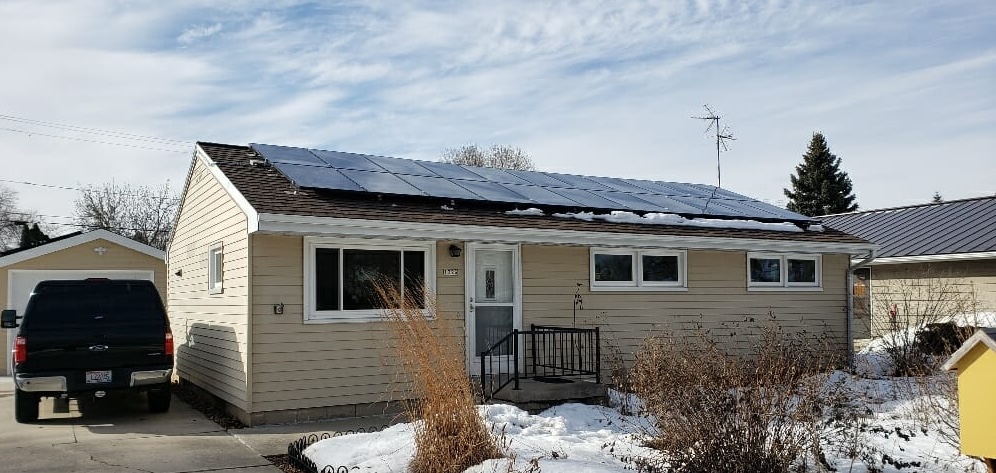
by RENEW Wisconsin | Apr 23, 2024 | Advocacy, Electrification, Press Release, Solar
The Environmental Protection Agency (EPA) has announced the recipients of the Solar for All grants, with $124 million in funding awarded to the Wisconsin Economic Development Corporation (WEDC) and Midwest Tribal Energy Resources Association (MTERA). This influx of resources will help to accelerate our state’s clean energy transition.
Solar for All will increase access to renewable energy for around 15,000 Wisconsin homes, including single-family, multi-family, or community solar projects. The grant awarded to WEDC will bring $62,450,000 to the state of Wisconsin, this historic investment will increase solar access for Wisconsinites across both rural and urban communities.
This down payment on our state’s clean economy signals a new day for renewable energy solutions for all Wisconsinites. RENEW applauds this critical step toward increased solar access and how it ensures every community can participate and benefit from clean energy. Communities across the state will experience reduced reliance on fossil fuels and expanded clean energy job creation as we build a healthier, more equitable clean energy future.
More on Solar for All:
• The Solar for All competition, which was created by the Inflation Reduction Act’s Greenhouse Gas Reduction Fund (GGRF), will expand the number of low-income and disadvantaged homes primed for residential solar investment.
• Wisconsin is one of 60 states, territories, Tribal governments, municipalities, and eligible nonprofits awarded grants to create and expand low-income solar programs that provide financing and technical assistance, such as workforce development, to enable low-income and disadvantaged households and communities to deploy and benefit from residential solar.
• The Solar for All competition will provide more than $7 billion nationwide to increase access to affordable, resilient, and clean solar energy for millions of low-income households.
RENEW congratulates Governor Tony Evers, WEDC, and MTERA on their work to ensure our state continues to bring renewable energy commitments to our state. This funding will help advance environmental justice efforts by enabling low-income households to access clean, resilient solar power, lowering energy costs, and creating good jobs in underserved areas.
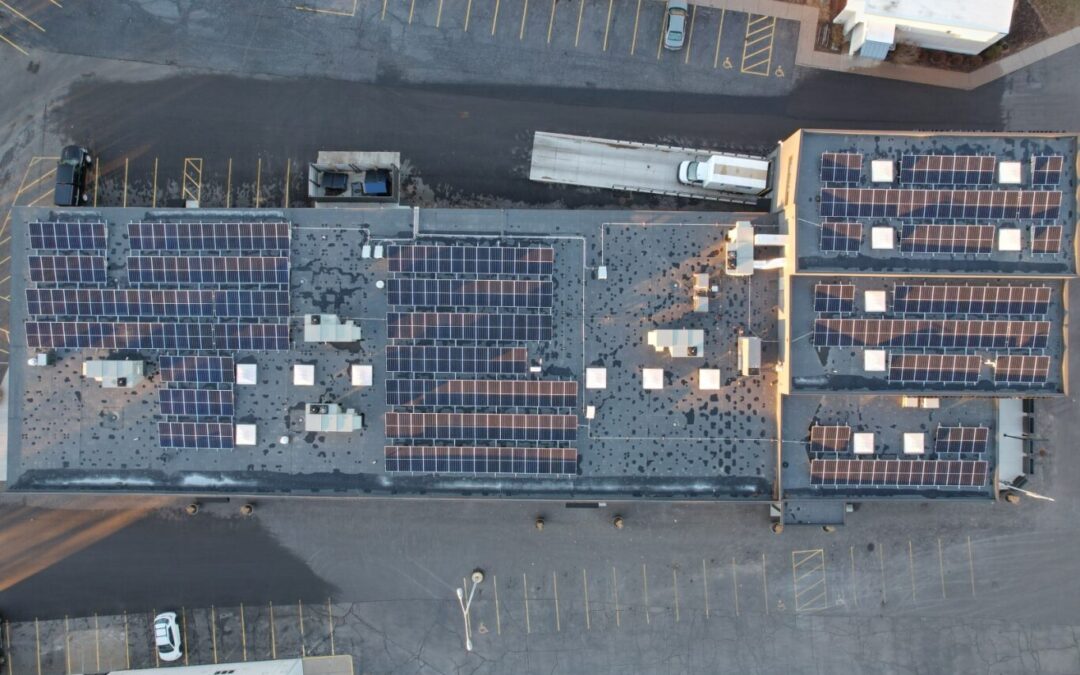
by Lauren Cohen | Apr 22, 2024 | Solar, Solar for Good
On Monday, April 22, 2024, Community Partners Campus (CPC) hosted a solar dedication ceremony to celebrate the completion of their new 142-kilowatt (kW) solar array. This event, which fittingly took place on Earth Day, marked a significant milestone for CPC, a facility dedicated to providing essential services to the most vulnerable residents of the greater Wausau area.
CPC’s mission is to provide a collaborative space for a wide range of human services, offering shared facilities for nonprofit partners dedicated to serving disadvantaged individuals and families. With core programs providing free services related to food, shelter, medical care, mental health, and social well-being, Community Partners Campus plays a crucial role in the community by offering essential services to those in need.
“As a facility that provides space to seven nonprofits that all provide basic needs services, solar is a great eighth partner, said Tara Glodowski, Executive Director of Community Partners Campus. “On Earth Day, 2024, we dedicated our new system and welcomed the array and the harvest from the sun’s power that it will provide. We look forward to reaping the benefits and being able to keep overhead costs low for our incredible teams that serve the most vulnerable community all under one roof.”
The decision to install solar panels at CPC was driven by the need to keep operational costs low for the seven nonprofits that operate under its roof. The facility, a 25,000-square-foot building, now boasts a 142 kW array that will produce 155,261 kWh of energy annually. This system will offset 29.2% of the campus’s annual energy usage, significantly reducing their energy bills. The solar project was made possible through the support of the Solar for Good grant, which has enabled CPC to maintain below-market rent for their nonprofit partners. This ensures that these organizations can continue to focus on their mission-driven purposes without the burden of high operational costs.
“It was a pleasure to provide clean energy to Community Partners Campus,” said Jordan Kaiser with Northwind Solar. “We’re tremendously grateful to be of service to an organization that does such amazing work in the Wausau community. To play a small part in their overall vision and mission has been a privilege for our company!”
Community Partners Campus’s commitment to sustainability and cost efficiency reflects its dedication to breaking barriers for the people and agencies it serves. By embracing solar energy, CPC not only supports environmental stewardship but also strengthens its ability to provide essential services to the community. This collaborative effort exemplifies how innovative solutions can enhance the impact of nonprofit work, ensuring that everyone has access to basic human needs in a safe and supportive environment.
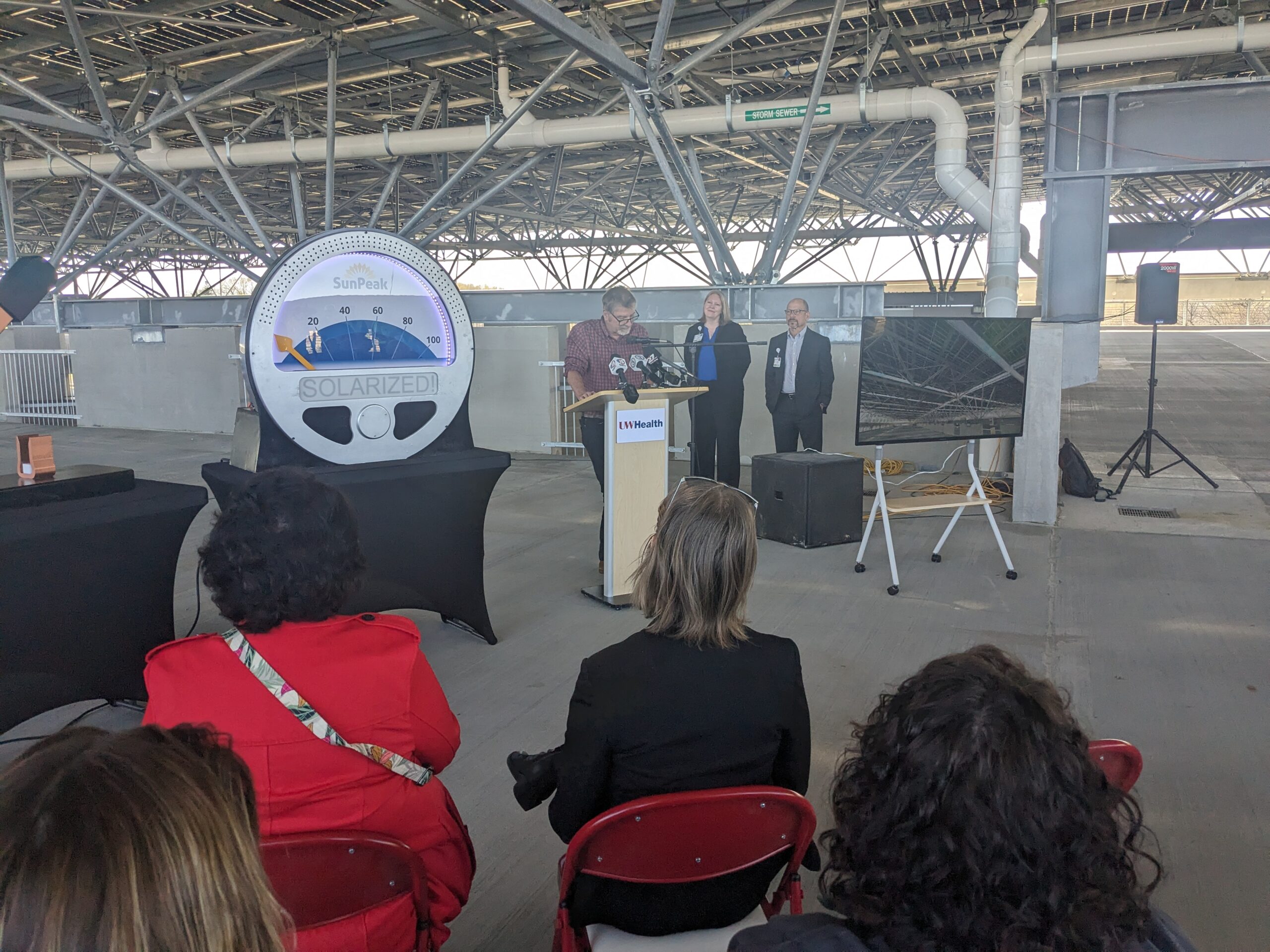
by Michael Vickerman | Apr 22, 2024 | Solar, Sustainable Business
Rarely does one experience a solar-themed celebration inside a large parking garage at an active construction site, but that didn’t stop UW-Health from throwing the symbolic switch to activate a recently installed 1.1 MW solar electric parking deck at UW-Health’s Eastpark Medical Center campus. The Eastpark Medical Center is scheduled to open in fall 2024.
Under a cloudless sky, luminaries such as Madison Mayor Satya Rhodes-Conway and State Senator Melissa Agard joined project partners and invited guests to hear UW-Health CEO Dr. Alan Kaplan, UW-Health senior vice president Katrina Lambrecht, and RENEW’s Michael Vickerman hail the many benefits provided by the gleaming structure above their heads. Images of the parking canopy can be accessed through the WKOW-TV news story filed later that day.
The Eastpark photovoltaic (PV) canopy, consisting of 2,064 panels, should produce enough electricity to power the proton therapy center planned for that location. The array is expected to produce approximately 1,260,000 kilowatt-hours of electricity each year, equating to the annual consumption of about 200 typical Dane County households.
The deck also serves as a cover that prevents rain, snow, and ice from penetrating the space inside, preventing potentially hazardous footing for patients and staff alike. Underneath the panels, a network of pipes will channel rain and melting snow from the array and transport the water into Madison’s storm sewer system.
In his remarks, Vickerman called attention to the array’s design. “You can site a lot of solar power on rooftops and other impervious surfaces if you plan for it from the get-go,” Vickerman said. “This particular application of solar energy doubles as an urban design feature whose footprint can fit entirely within a larger structure.”
At its February 2024 annual summit, RENEW presented a Clean Energy Honor Roll award to UW-Health and its project partners–SunPeak and Staff Electric–for envisioning, designing, and constructing the largest solar-powered parking deck in Wisconsin. The Eastpark PV canopy was one of 13 installations or initiatives to receive such honors this year.
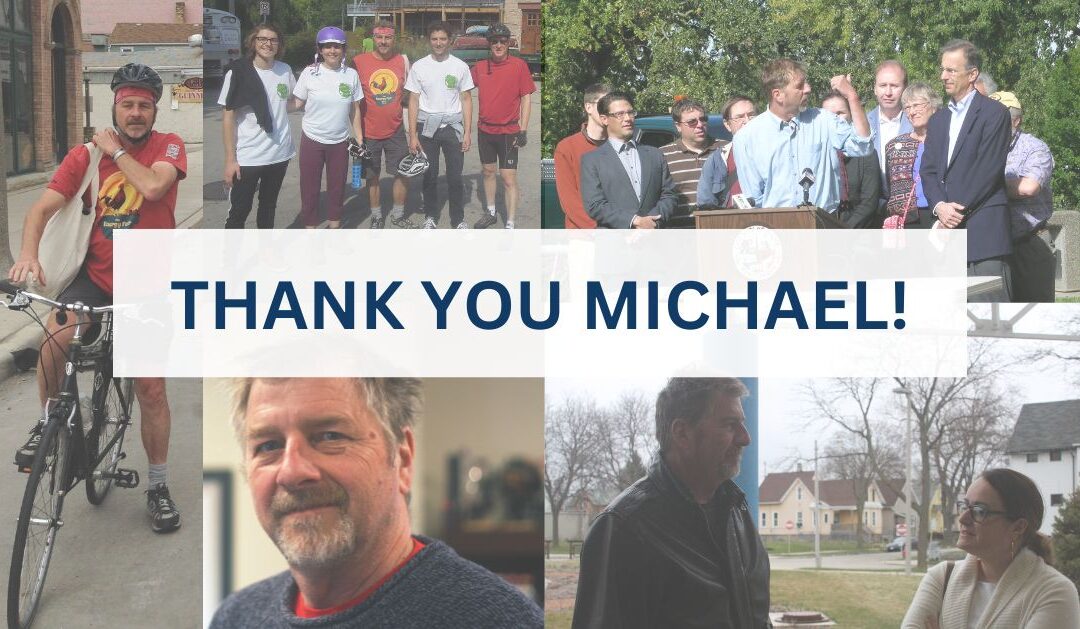
by Alex Beld | Apr 22, 2024 | Press Release, RENEW Wisconsin
After a long career at RENEW Wisconsin, advocating for renewable energy across the state, Michael Vickerman has announced his retirement effective April 20, 2024. Vickerman’s professional legacy spans over 33 years and demonstrates his tireless commitment to Wisconsin’s clean energy transition.
Vickerman got his start at RENEW after responding to a classified ad for a limited-term program coordinator at the nonprofit. For eight years, he served as the sole employee of the organization. He was pivotal in shaping renewable energy policy and fostering collaboration among industry stakeholders.
“No individual has done more to advance renewable energy in the Badger state than Michael Vickerman,” said Sam Dunaiski, Executive Director of RENEW Wisconsin. “He has ushered advocates and professionals through every Wisconsin clean energy challenge and success over the past thirty years. His knowledge, patience, humor, and guidance are unmatched and will be missed at RENEW.”
During his three-decade stint with RENEW, Vickerman held several positions within the organization, serving as Executive Director, Program and Policy Director, and most recently, Clean Energy Deployment Manager.
“Though we’ve had our ups and downs, renewable energy continues to grow in ways that benefit farmers, businesses, communities, and taxpayers,” Vickerman said. “During the early years, it would not have been possible to foresee a future when every power plant in Wisconsin energized in one year would be powered by sunshine and wind energy. But that’s exactly what happened in 2023. Would that have been possible without RENEW’s advocacy over the years and decades? I doubt it.”
“As RENEW has expanded from a single employee to a 13-person staff, our ability to influence and shape state energy policy continues to grow,” Vickerman said. “It will be sad to part company with such a talented group of colleagues, but I have every confidence in their capacity to meet the challenges that lie ahead.”
Vickerman will remain connected to the nonprofit as a member of the board of directors. In his new-found free time, he plans to raise a new puppy with his wife Pamela, garden, and ride his bike around Madison while sustaining his connection to Wisconsin’s renewable energy community.

by Aisha Anderson | Mar 28, 2024 | Community, Events, Inflation Reduction Act
On Wednesday, March 27, Walnut Way welcomed the U.S. Department of Energy (DOE) Secretary Jennifer Granholm to their site, opening up a conversation about shared priorities in uplifting progress for environmental justice communities and the transformative nature of the DOE’s involvement in helping the country reach decarbonization goals.
“What a massive honor to host Jennifer Granholm to Walnut Way, having the opportunity to showcase the transformational work being done with community-led comprehensive development,” said Antonio Butts, Executive Director of Walnut Way. “Because of the work being done at the DOE, we can use these grants to further the development of our neighborhood and provide green energy opportunities for low to middle-income individuals, sustainably transforming the city one grant at a time.”

Photo Credit: Clean Economy Coalition of Wisconsin
“The Inflation Reduction Act (IRA) and the Bipartisan Infrastructure Law (BIL) are geared towards healing the rift of the past,” said Granholm. “We want to emphasize and empower communities to have a voice. This can be seen through grant stipulations such as the Community Benefits Agreement (CBA). With the CBA, we wanted to provide a vehicle to empower communities to speak and be heard.”
During her visit, Secretary Granholm participated in a roundtable facilitated by Butts. While leading the roundtable, Butts outlined Walnut Way’s work to elevate the voices of those in the community who haven’t previously had a seat a the table for environmental justice work and the community impact of helping weatherize and install renewable technology on homes in the neighborhood.
Granholm heard several concerns from Butts and others. In her response, she emphasized an upcoming IRA program to help low to moderate-income households with appliance rebates.
“But what we’re going to need is we’re going to need partners on the ground to be able to get the word out to people so they know that these are going to exist,” Granholm said. “Now, it comes through the state and Wisconsin has pledged to by June to roll out their program.”
Granholm shared that the program, for example, might be able to help people replace a worn-out furnace or air conditioning unit with a more expensive heat pump — a more efficient device that transfers energy instead of mostly producing it with fossil fuels.
Butts said the conversation was productive and noted that initiatives from the DOE and programs implemented through the IRA are key in accelerating clean energy solutions — specifically for low and moderate-income people.
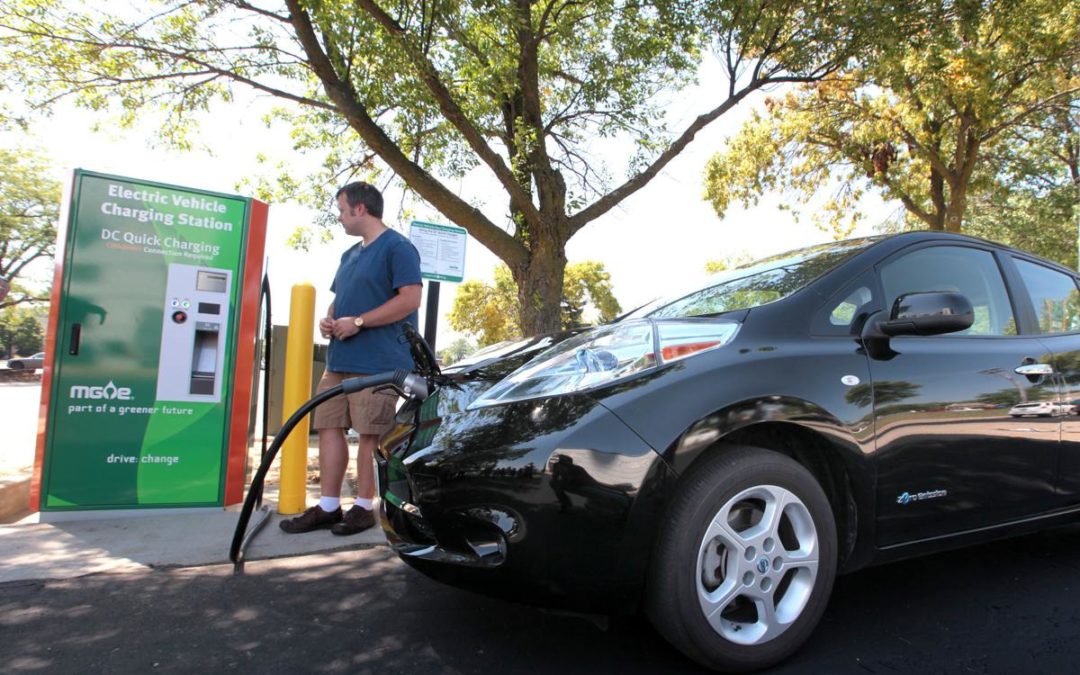
by Orrie Walsvik | Mar 14, 2024 | Electric Vehicles, Electrification, NEVI, RENEW Wisconsin
On March 12, 2024, the Wisconsin State Senate passed Bills 791 and 792, allowing electric vehicle (EV) charging stations to charge by unit of electricity instead of time spent charging. The bill helps provide clean energy access to all Wisconsinites and is a testament to Wisconsin’s commitment to embracing new, proven clean energy technologies. The new law addresses several critical areas to standardize EV usage and infrastructure deployment for private developers. Let’s dive into some of the key parts.
NEVI Funding Unleashed
The cornerstone of the bill is the activation of National Electric Vehicle Infrastructure (NEVI) funding for “Level 3” fast chargers. This funding, totaling a substantial $78 million of federal dollars for Wisconsin, will be channeled toward the building, operation, and maintenance of fast-charging stations across the state. These fast chargers, capable of significantly reducing charging times for longer trips, are vital for reducing range anxiety.
Charging All Over the State, Not Just in Cities
NEVI funding also avoids putting the cart before the horse by providing charging stations across the state, along highway routes for the next five years, paying for the cost of the station, the operations, and the maintenance. Check out the map below to see the routes.
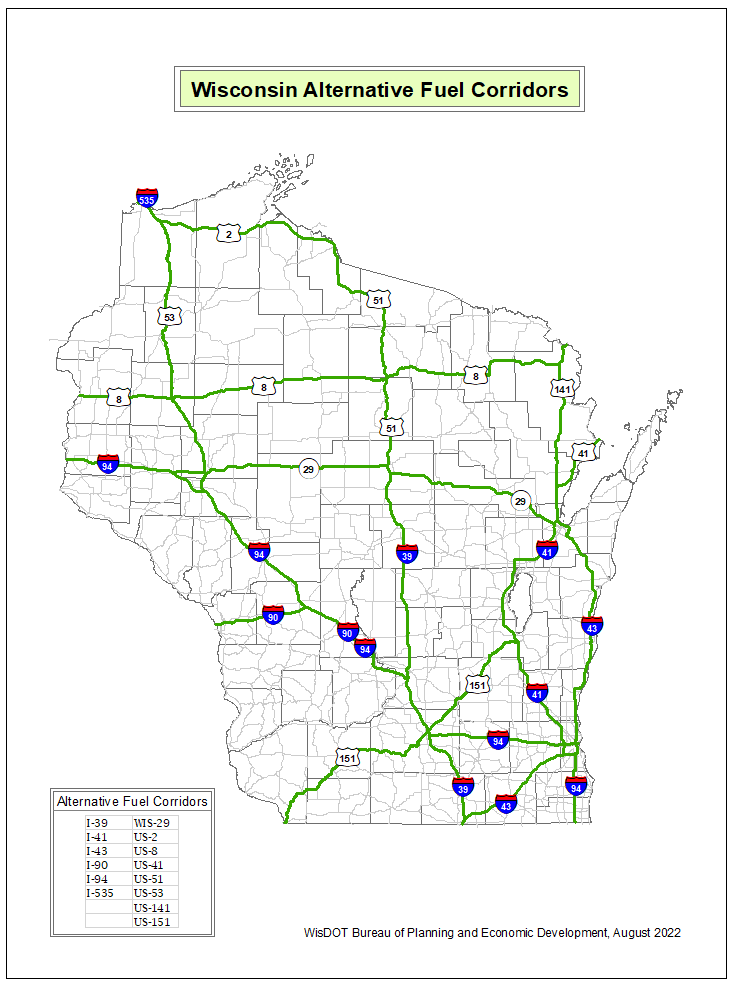
Jobs, Training, Reliability & Safety
But the bill doesn’t stop there. It also emphasizes the importance of training, ensuring that those responsible for these chargers are equipped with the skills necessary to maintain their reliability and safety. Chargers must be operable at least 97% of the time to receive the funding. This commitment to training not only boosts job opportunities but also ensures that the infrastructure remains robust and dependable.
Protects Level 1 and Level 2 Chargers
The Legislation clarifies that residential Level 1 and Level 2 chargers are clear of tax and regulation. It also provides regulatory certainty for groups looking to install public level 1 and level 2 chargers to avoid classification as a public utility, clearing up a large regulatory hurdle for EV Charging implementation. This protection ensures that these residential and light commercial chargers have a realistic path forward in Wisconsin. This move is a win for EV owners and businesses alike, fostering a more flexible and user-friendly charging landscape.
Tax and Road Fund
A tax, similar to the gas tax, of 3 cents per kilowatt-hour (kWh) of electricity used for charging will be implemented for public EV chargers. This measure brings EVs in line with gas and diesel cars. Charging by the kWh also ensures customers pay for the amount of fuel received instead of the amount of time spent charging, a policy that favored individuals with more expensive cars. Now, all users will pay a fair price for their power and end the inequity of time-based charging. Unfortunately, EVs are still required to pay $175 for registration, $75 more than fossil fuel cars.
This bill pairs regulatory certainty for charging station owners with equitable locations and rates for EV drivers. The bill also clarifies how and when local governments can own EV charging stations, and does not effectively change the situations of previously existing chargers.
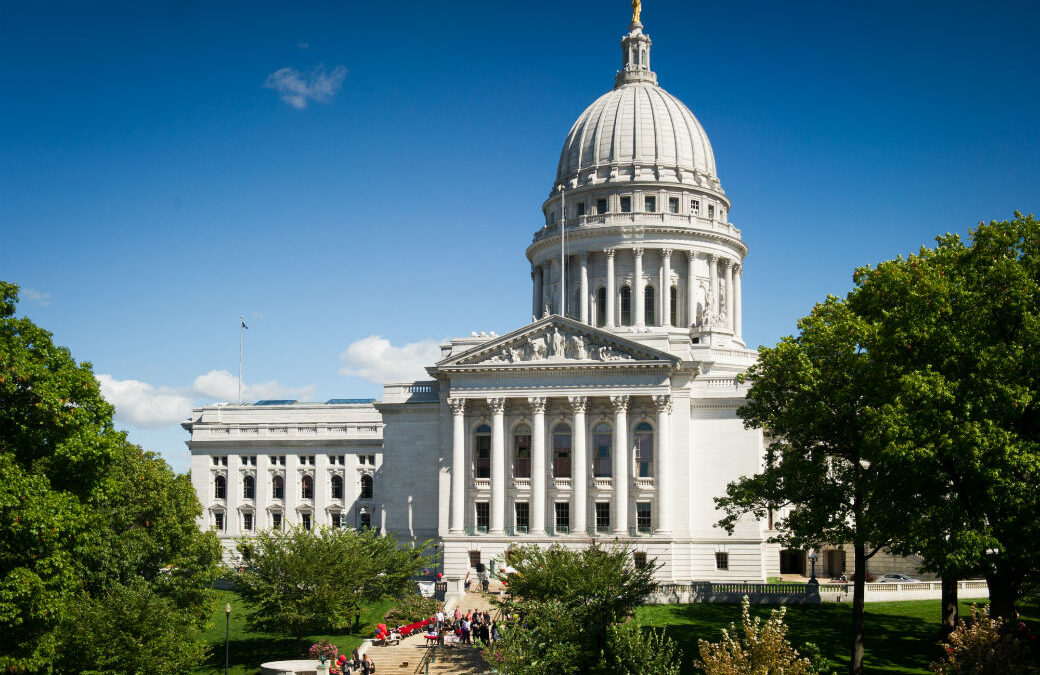
by Beata Wierzba | Mar 14, 2024 | Advocacy, Electric Vehicles, Legislative Watchlist, Local Government, NEVI, Solar
As the legislature wraps up for this session, RENEW is celebrating several victories and reflecting on some of the other renewable energy measures being considered by the state legislature.
Big Win for Electric Vehicle Infrastructure
Senate Bill 791, the Electric Vehicle Charging Bill, passed the legislature with several amendments. The legislation exempts private entities that develop charging stations from being regulated as a public utility but allows them to measure the cost of electricity used for charging EVs by the kilowatt hour (kWh). Establishing this new kWh standard to calculate how much electricity is used, rather than how long it takes to charge the vehicle, provides an essential uniform requirement for the industry. It is also required by the National Electric Vehicle Infrastructure (NEVI) Program for Wisconsin to qualify for $78 million dollars in federal funding, an 80% cost share, for level 3 chargers to build corridors for charging. RENEW will be developing a detailed overview of the passed legislation for those interested in more information. The bill received bipartisan support and limited opposition. In other actions related to electric vehicles, the Legislature also passed SB 792, which establishes the infrastructure program and enables the state to utilize the federal NEVI funding. Additionally, with the passage of SB 617, the DOT will issue registration plates or stickers for existing license plates that indicate the vehicle is electric.
Progress on Community Solar
The community solar bill, Assembly Bill 258, did not pass either the Senate or Assembly but did get a hearing in the Assembly Committee on Energy & Utilities. This is a significant development considering the heavy opposition from Wisconsin Utilities. The public hearing was a great opportunity for the benefits of community solar to be shared with state legislators. During the hearing, supporters of community solar were able to answer questions, correct misinformation, and show their unity and strength. Establishing a community solar program for renewable energy generation is essential for those without the option to install panels on their own roofs, or the financing necessary to cover costs. Under the community solar arrangement, the participants subscribe to the developed project and receive a credit on their electric bill for solar electricity generated on panels installed in a community setting. The developer arranges permitting, financing, and installation, as well as maintenance. If passed, the legislation would require approval of the location by local governments and be limited to 5 megawatts or about 26 acres. Each project would also require at least four subscribers. With fierce opposition in some areas to larger utility-scale operations, the community solar model is a better fit.
Other Legislative Wins
There were numerous bills that aimed to limit renewable energy development, including restrictive sitting and increased regulation. They did not pass, and in most cases, did not receive a hearing. These bills ultimately died in committee.
Assembly Joint Resolution 6
Assembly Joint Resolution 6 (AJR6) would give the Wisconsin Legislature control over how federal funds are spent, rather than the Governor, on behalf of the state. Recent examples of federal funds distributed to the states include the Inflation Reduction Act (IRA) and the Bipartisan Infrastructure Law (BIL), both have benefited Wisconsin’s clean economy. The Wisconsin constitution directs the Governor, as head of state, to oversee disbursement. In order to change the constitution, identical legislation has to pass the legislature twice in a row and then be considered by state voters. Because it is not regular legislation but a joint resolution of the legislature, the Governor does not have veto power. After the passage, the resolution language will become the referendum during an upcoming election, with the resolution language being the exact question asked. If voters approve the referendum, the state will need to modify the constitution. The consequences of this change can impact many efforts, such as conservation measures, disaster relief funds, higher education, and more. The earliest statewide election when this referendum can be placed on the ballot is the August primary. Efforts are on the way to provide information and educate the voters on the impact the change could have on issues of importance to them.
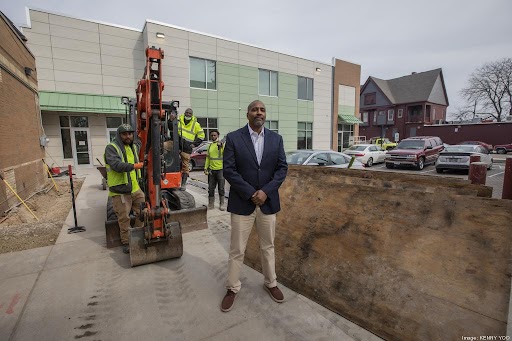
by Aisha Anderson | Feb 26, 2024 | Community, Community Change Grant, Inflation Reduction Act
Photo Credit: Walnut Way
Walnut Way, Community Change Grants and how their benefits can be leveraged to reduce environmental disparities in Milwaukee’s Northside
Clean energy dollars are reaching Milwaukee’s most underserved communities thanks to federal funding through the Inflation Reduction Act (IRA). With over 20 years of experience as an environmental nonprofit in Milwaukee’s northwest side, Walnut Way Conservation Corp. has established itself as a trusted resource for Lindsay Heights residents and statewide organizations through its commitment to creating healthier, safer, and more prosperous communities.
One of the ways this will be done is by the creation of a one-megawatt microgrid within the Lindsay Heights community. This will support the integration of clean energy into the electricity grid and protect grid reliability.
These place-based investments will be focused on initiatives led by the community members of Lindsay Heights, ensuring they are responsive to the community. They are designed to deliver on the transformative potential of IRA for communities most adversely and disproportionately impacted by climate change, legacy pollution, and historical disinvestments.
Antonio Butts, executive director of Walnut Way, said, “Over the past two years, significant work has been done in Milwaukee to address energy burden, energy affordability, and sustainability projects in underserved communities. This work has involved engagement in utility rate cases with the Public Service Commission of Wisconsin, cross-sector collaborations with local grassroots organizations, and partnerships with various state agencies.”
Through the EPA’s new Environmental and Climate Justice Community Change Grants, Walnut Way has the opportunity to move forward with its multi-million dollar proposal intended to advance sustainable change. The Community Change Grants, which were developed as a comprehensive response to pressing environmental concerns, leverage the collective strength of Walnut Way and its partner organizations by deploying a budget of approximately $20 million to be distributed over 36 months. Walnut Way’s proposal is specific to Milwaukee’s Lindsay Heights Neighborhood with the goal of increasing education, capacity building, governance participation, and environmental stewardship. The goal is to reduce the energy burden within the community and promote renewable energy sources among residents.
Overall, the project aims for a holistic transformation of urban infrastructure and the creation of a sustainable, equitable community.
Community Impacts: Direct Financial Assistance, Energy Independence, and Home Weatherization
“This grant opportunity is designed to fund community-driven projects that address environmental and climate challenges and enhance meaningful involvement in government processes related to environmental justice,” said Butts.
For Walnut Way, this starts with direct financial assistance to Lindsay Heights residents. The budget for the proposal outlines $3 million in direct assistance over three years to alleviate financial burdens associated with the cost of food, medical supplies, energy-efficient appliances, and utility bills.
Walnut Way has budgeted an additional $2 million to extensively weatherize 300 homes in the community. Weatherization services include upgrading appliances such as stoves and refrigerators to more energy-efficient models, installing heat pumps, and updating roofing in preparation for solar panel installation.
More notably, the initiative has allocated $1.5 million to implement a 0.5 MW microgrid for subscription-based renewable energy access. This project has been created to mitigate the high electricity bills and disconnection performed by the local utility company and will be done in partnership with Watts Up Way, an apprenticeship program born out of Walnut Way to support a clean energy transition, enhance energy independence within the community, and promote clean energy jobs.
To reduce the energy burden of residents, Walnut Way has budgeted $2 million to weatherize 300 homes in the community.“Our goals are ambitious,” Butts said, “And in order to complete these goals, it’s going to take a collective effort. Our objective is to sustain our engagement and ensure that generations to come have a voice that directly impacts our well-being and quality of life.”
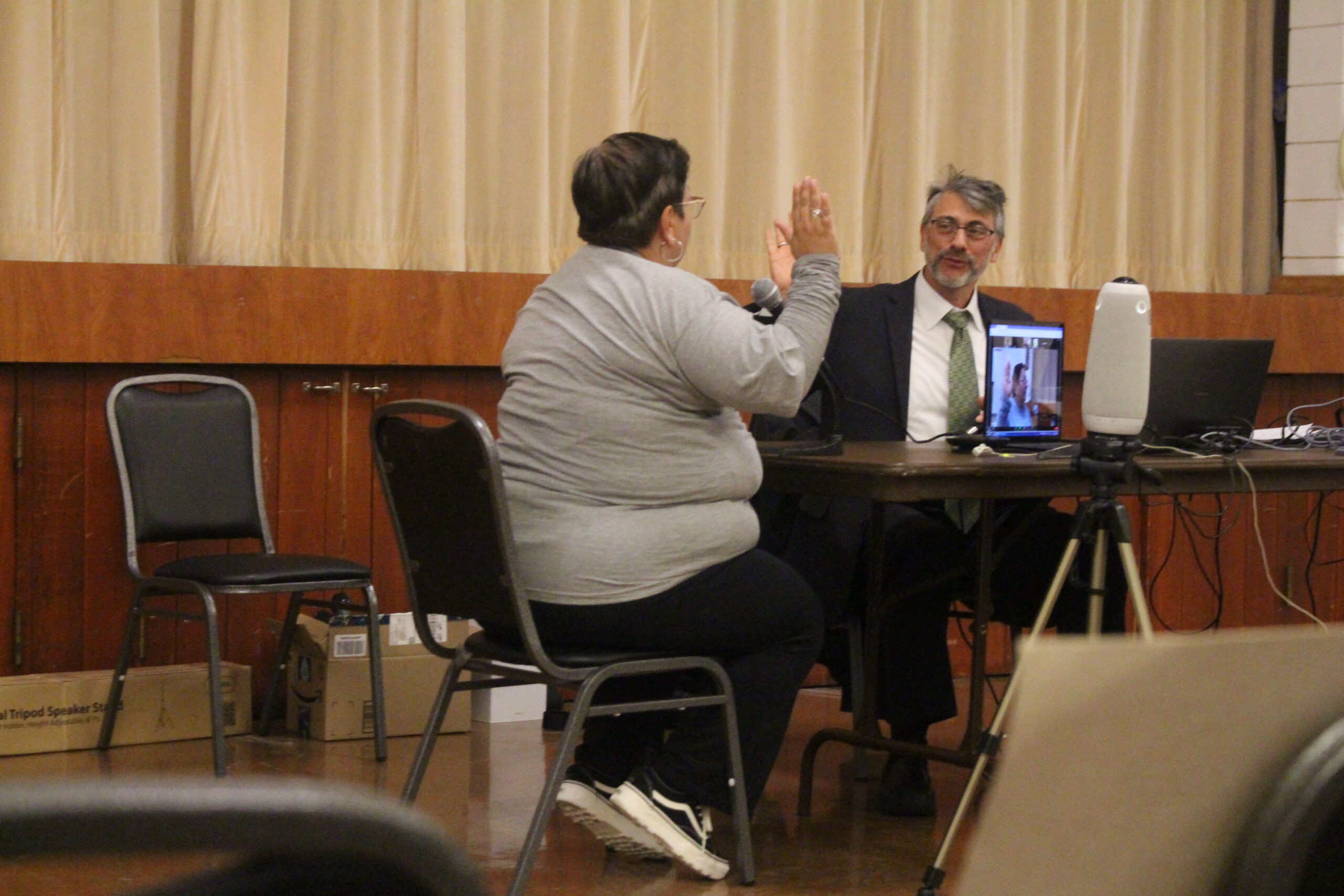
Photo Credit: Walnut Way
The Importance of Community-Led Transitions to Energy Justice
A critical element of this effort is the Resilient Resident Civic Engagement Compensation Program. This innovative program by Walnut Way provides a strategy for community members to gain recognition and compensation for their contribution to the project, providing a way to earn additional income and engage in civic activities.
The objective of this is to provide an avenue for transparent two-way communication, leadership, and adjustment between government entities and constituents to build trust within the community. For Walnut Way, community engagement has always been the foundation for achieving sustainable change. This is apparent in conversations among Walnut Way and Lindsay Height’s residents when asked about their vision for the community moving forward.
The desire for change among residents is not scarce, but the means to make improvements have been.
“The reality is that we need to take advantage of all available resources,” Butts admitted, and “especially listening to our community members. They live here. They know what they need to be successful.”
He continued, “Being held accountable by the residents requires us to be aligned, coordinated, and to already have established a baseline of accomplishments for us to earn their trust.”
“Working alongside residents enables us as an organization to respond with confidence to aid the community moving forward,” Butts said.
Emmonia Barnett, who has lived in Lindsay Heights for over ten years, shared, “My vision is a community that is empowered to look after itself.”
Her neighbor, Ammar Nsoromoa, echoed Barnett’s wishes and added, “I would like the community to be beautiful. You don’t see trash. You don’t see people in poverty. The community is self-sustained. We take care of one another. The businesses serve the locals. We feed each other with food from grocery stores in our neighborhood. We want to be actively a part of what’s going on.”
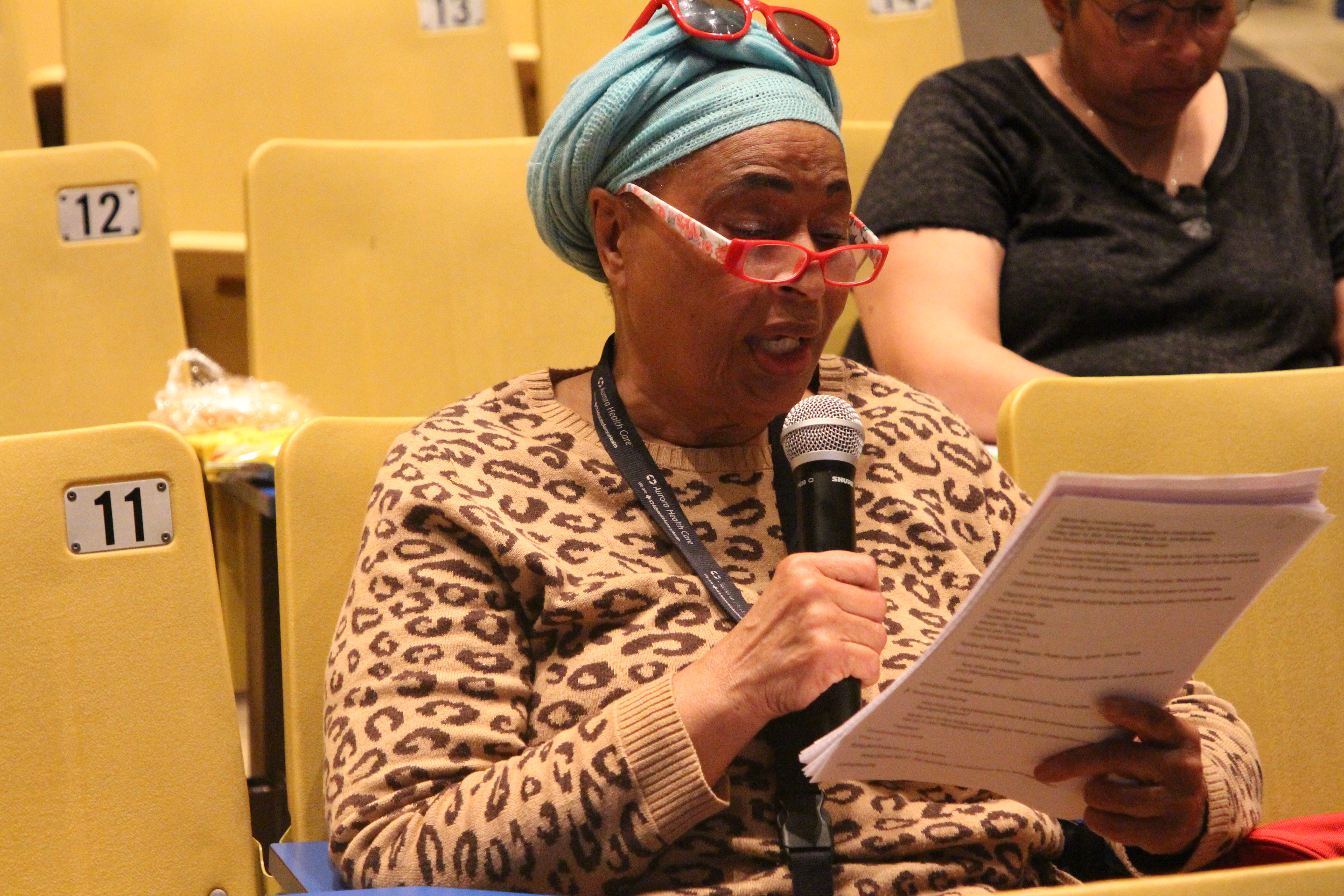
Photo Credit: Walnut Way
EPA Grant deadlines, technical support, and how to bring change to your community
While Walnut Way is still in the preliminary stages of the grant application, the Notice of Funding Opportunity is open now through November 21, 2024, with applications accepted on a rolling basis. Additional support for organizations and communities seeking technical assistance with grant eligibility and technical writing will be provided through the EPA’s Environmental Justice (EJ) Thriving Communities Technical Assistance Centers (TCTAC). The creation of these centers was a direct response to feedback from overburdened communities and organizational leaders who have encountered barriers to maximizing the full benefits of available federal funds.
There are the two TCTACS serving Region 5 organizations and communities that have been disproportionately impacted by environmental hazards. As designated by the EPA, Region 5 spans 35 tribal lands and six states–Illinois, Indiana, Michigan, Minnesota, Ohio, and Wisconsin. The Great Lakes, led by the University of Minnesota, and Blacks in Green (BIG) Justice, led by a partnership of community-based organizations in Illinois, are the two TCTACs that serve Region 5. Interested applicants can submit an intake form detailing their needs to either center to get help with overcoming barriers to accessing funding from the Community Change Grants.
“Our objective is to sustain our engagement and ensure that generations to come have a voice that directly impacts our well-being and quality of life,” Butts said.
He also noted that the Community Change Grants program has the capacity to expedite this process for the residents of Lindsay Heights while allowing the community to lead in its own solution development towards the clean energy transition.














